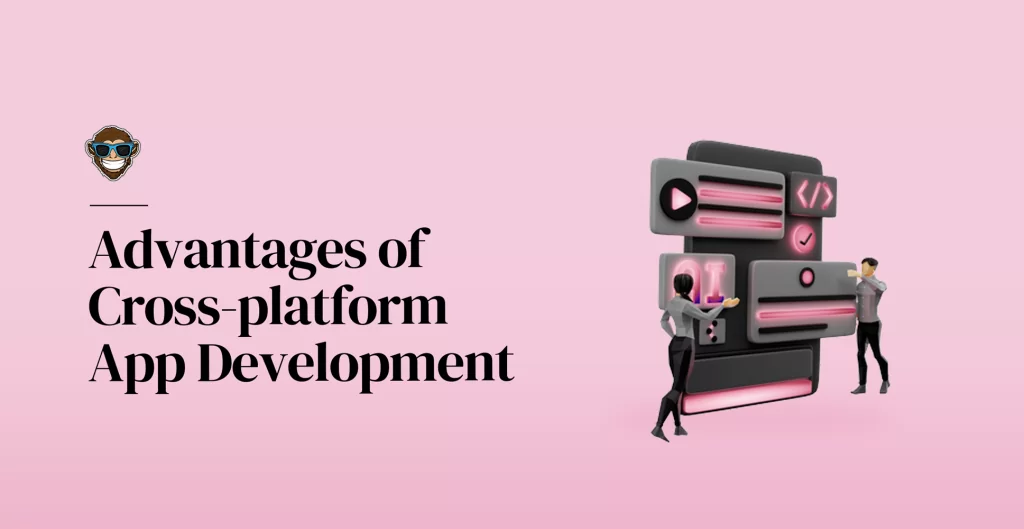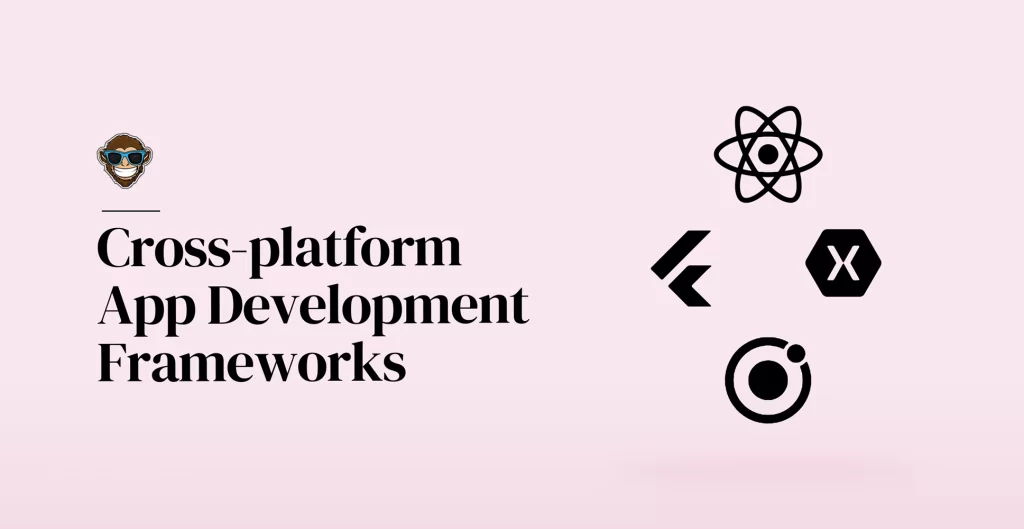Cross-platform app development is the gateway to faster, more scalable, innovative, and robust mobile products that meet user expectations and stand the test of time. It’s not easy, but with our guide, you can successfully enter the world of cross-platform development and become a relevant, out-of-this-world app developer.
Today’s fast-paced, tech-dependent life affects every aspect of how the world works. From online purchasing to remote working, humanity’s day-to-day is now governed by apps and mobile technologies that, for over a decade now, have been slowly becoming as necessary for our lives as the air we breathe. As a result of this phenomenon, we have become more demanding of the quality of the service we access. The mobile technologies we purchase or download must meet specific standards if we are going to let them inside our devices and into our world. Consequently, the mobile app development world has become highly competitive. Only the most disruptive, innovative, and robust developers are destined to stand out and ship products that will add value to our already crowded lives. Hence, developers, startups, and businesses can’t risk losing valuable users by not standing out because they won’t work on all operating systems (Android, Windows, and iOS) or because they’re not part of both platforms, Apple’s App Store and . Modern mobile products need to gain valuable ground on all fronts. For this, app developers must understand what cross-platform app development means and how to do it successfully.
With cross-platform app development, companies of all shapes and sizes have the chance to produce the most capable, innovative, and popular applications to drive their businesses forward and thrive on all fronts without having to go through complicated, expensive development processes. So, as experienced cross-platform app developers, we at Foonkie wanted to guide you on your journey into the world of cross-platform app development and shine some light on what the process entails. So, let’s get to it.

What is Cross-Platform App Development?
Gone are the days when most app developers targeted a single platform or operating system and shipped apps that did thrive but only on one OS. However, nowadays, most relevant app developers are continually looking for the most innovative tools, platforms, and frameworks to simplify our jobs and make the development process easier, faster, and more efficient. Here’s where cross-platform app development comes in.
Cross-platform app development is an approach to mobile app development that allows developers to build a single application that works on different platforms. Cross-platform apps run efficiently, are simultaneously compatible with various operating systems (Android, iOS, and Windows), and are available on all platforms and app stores. Unlike native app development, where you have to build several app versions for different OS, cross-platform app development allows you to create one application for various platforms and systems. As a result, cross-platform apps are more cost-efficient, productive, robust, and help your mobile product reach a broader audience without extra time or monetary investments. Moreover, with cross-platform app development, mobile products have a shorter time to market because you’ll only need to write the source code once and use it on all platforms.
Furthermore, about 70-90% of the code written in cross-platform app development is reusable, meaning that instead of needing to build separate codebases for iOS and Android, with cross-platform app development, you’ll only need one. These benefits, and much more, are what make cross-platform app development the godsent it is for development practices across the globe. We’ll dig deeper into them in a minute. But, first, and to provide some context, let’s answer some vital questions: what about native app development? Does it still work? Is it still relevant? Do you need it?

Native App Development
As stated earlier, native app development requires mobile products and their code, APIs, and frameworks to be selected, built, and designed to run only on a single operating system. Developers must choose the programming language, architecture, and most of the functions and components to be compatible with a specific operating system, meaning the app won’t work on a different platform. For instance, for iOS app development, you can use Swift or Objective C languages, while for Android, you must use Java. At first glance, this specificity sounds like a flaw. However, it’s quite the opposite. Native app development allows developers to take full advantage of the features inherent to any particular platform and OS. As a result, native mobile products run better, have high-performance, more complex functionalities, are more stable secure, and possess outstanding user experience. Native apps are also more customizable and are tailored to the environment and peculiarities of the specific platform and OS they are running in.
So, which one is better? Choosing between native and cross-platform app development is a never-ending dispute inside the app development industry. Both frameworks have their own flaws and perks and which one you choose depends entirely on the type of app you’re developing, your team, your budget, your state of business, and your client’s demands. On the one hand, native app development forgoes the complexity of building a mobile product that scales and successfully supports multiple platforms. On the other hand, it focuses on a single OS, making mobile products more reliable, efficient, and of higher quality. But they are expensive, require your workforce to have a specific set of skills, target a limited user pool, and the code you build isn’t sharable; if you want to develop for another platform, you need to start over. Also, all different code bases must be individually maintained and updated, meaning you’ll have to do twice the work, spend twice the time, and hire twice the people. Not everyone has the resources for that.
With cross-platform app development, you have the best of both worlds. You can build an app that reaches out to as many users as possible by covering ground on all platforms and devices on the market. Also, rather than spending more time, hiring more developers, and investing tons of money in developing multiple app versions for numerous platforms, you can use cross-platform app development to launch one app for every OS. And, if you got concerned when you read earlier that native apps are more stable, reliable, and perform better, your worry is misplaced. Cross-platform app development tools, frameworks, and supporting technologies are constantly evolving and innovating to promote better, more stable, and durable apps. As of right now, cross-platform app developers have access to these tools that, when implemented correctly, can end up in mobile products that run just like native apps with the benefit of less time, money, and energy invested in them.
So, now that you know most of the differences between native and cross-platform app development, and since the primary purpose of this article is cross-platform app development, let’s dig a little deeper into the main advantages and drawbacks of cross-platform app development.

Advantages of Cross-platform App Development
Faster Development
Since cross-platform app development only requires you to deploy a single script and allows you to use the same code base for all platforms, the entire development process of your app is shorter. This significant increase in the speed of the time of development cuts time to market, benefiting everyone involved in the process, from your developer teams all the way to your client and your product’s users. It also helps you easily meet deadlines and avoid delays that can become a hassle for all parties. Moreover, it has been proven that using the same source code for mobile products that will function on multiple platforms can reduce development times by nearly 50 to 80% and save your company some big bucks! Also, if you choose the adequate technical stack (more on this later), you can reuse even more than 80% of the source code on both the User Interface (UI) and backend logic on all operating systems.
Reach A Broader Audience
Since cross-platform app development allows you to build a product for all platforms, it offers you and your app a unique opportunity to reach a broader audience than you would with a native app. When you have a mobile product that is compatible with multiple operating systems and can be available on several platforms simultaneously, a more significant number of users can see it. More users can also download it and use it, making it a great way to maximize your app’s exposure with significantly less time, effort, and cost.
Easier Maintenance, Updates, and Deployment
Cross-platform app development makes it easier for you and your team to maintain and update your app, which, as you know, is just as important as any part of a successful product’s development process. For instance, if your team finds a bug or a glitch in the codebase, they would only need to fix it once and deploy any code changes only once as well as they are made. This way, you can save valuable time and monetary resources that you can put to better use on other more crucial aspects of your product.
Also, the fact that most cross-platform apps are internet-based allows you to provide updates faster and more efficiently, saving your users the need to download multiple updates every time. In that sense, the app is automatically updated for all users in all platforms and operating systems without developers needing to release different updates for different app versions. That way, you can ensure your users always have the latest app version that always functions optimally.
Faster Time-to-Market (TTM)
The development of most mobile products and their release is oftentimes time-sensitive for various reasons, most of them due to an urgent need for the product to hit the visual shelves. In the development world, this time is often referred to as Time-to-Market (TTM). TTM is the time it takes developers to ship a mobile product, from the initial research and conceptualization to its design and development and up until it is live and ready for its audience to download it. Its own definition highlights the importance of TTM in the modern, extremely competitive world of mobile apps. Those developers who are capable of bringing their apps to fruition faster are the ones that have the edge over their competition. They are also the ones with the strongest position to lead the market. In that sense, cross-platform app development is the key to faster TTM because it sets the ground for more rapid development, deployment, updates, and maintenance.
Cost-Effectiveness
All of the advantages mentioned above, and many others we might be missing, unavoidably end up in significant cost savings. And isn’t that what we all want? With cross-platform app development, developers leverage unheard-of development speeds, faster time-to-market, easier maintenance, and better updates and translate all those benefits into valuable cost savings.
Cross-platform app development also produces apps that are fully compatible with all or most cloud settings. As a result, you can easily integrate them with myriad plugins, tools, and technologies that are extremely valuable when using the cloud. In that sense, you can sync your app’s source code with various extensions that can promote its scalability and power numerous functionalities, resulting in lesser money spent on doing those same processes many times for each platform. Additionally, you can use one team to develop your app instead of several single-platform teams, which cost more and take longer to ship products. Maintenance is also less costly and faster since you only have to do it once for all operating systems.
All of these points mean that, with cross-platform app development, you can get your product developed faster and more efficiently, which will lead to higher revenues and adoption much sooner than with native app development.

Cross-platform App Development Frameworks
Now you know what cross-platform app development can do for your company and the products you deliver. But, how do you get there? As mentioned before, cross-platform app development allows you to take advantage of various tools and technologies to deliver fast and reliable apps quickly and reliably. And hopefully, this far into our article, we’ve already managed to somewhat convince you that cross-platform app development is an approach to app development worth taking a second look at. So, now, we want to guide you into some of the frameworks and tools you can use in cross-platform app development. Here are our recommendations based on the ones we’ve used and those that are the most popular and relevant ones:
React Native
React Native, one of our preferred cross-platform frameworks, was introduced in 2015 by Facebook, and since then, it has taken the app development world by storm. It is one of the most popular mobile application development frameworks with a whopping 38% of the market! React Native is an open-source, cross-platform app development framework that builds on JavaScript, one of the most popular programming languages, and supports Objective C, Kotlin, Java, and Swift.
React Native’s popularity is likely due to the fact that, unlike other tools that also use JavaScript, all of the apps’ UIs that you develop using React Native are fully native. What does that mean? It means that this popular framework produces cross-platform apps that also have native capabilities, so you get the undeniable perks of native app performance and appearance without having to write in different languages for different platforms. Also, you can write most of the app’s elements, such as colors and buttons, to reflect native ones. In other words, you get the benefits of cross-platform app development but deliver a product that is indistinguishable from a native app. Here are some other benefits of React Native:
- It supports third-party plugins.
- Provides a native-like experience.
- It has a simple UI and is open source.
- It has Hot-reload, a feature that allows developers to see code changes in seconds even when they don’t save them first.
- It results in a more stable mobile app compared to other frameworks.
- It allows you to reuse 90% of the code for different platforms.
- Since it’s the most popular framework, it has a significant support community.
But, since nothing is perfect, React Native does have some drawbacks we have to point out:
- Some aspects of React Native are not fully cross-platform. Your team might still have to write separate code for Android and iOS for some capabilities.
- Some updates aren’t consistently released.
Some of the most popular apps made with React Native are:
- Bloomberg
- Skype
Flutter
Flutter was launched in 2017 by Google as an open-source, cross-platform development framework that has advanced SDKs designed to support high-performing Android and iOS apps. It is currently the most popular and loved cross-platform framework with a 42% market share, 4 points over React Native, and almost 30 over the rest of the frameworks on the market. However, this competitive edge didn’t happen by accident. Like all cross-platform development frameworks, Flutter allows you to use a single codebase for all operating systems, but it builds on Google’s Dart programming language. Dart offers developers the ability to write code faster, and it’s easy to learn and execute, making Flutter the ideal framework for MVP development. As a result, you can save valuable resources on coding times spent on building two separate apps, and, as you already know, an MVP is the ultimate money-saver for your company. In addition, you’ll end up with a mobile product that has the flawless looks and performance of a native app and works on all OS. And you can also scale using to build a serverless app.
Flutter uses widgets as its core element for building apps. These widgets allow you to create the building blocks for your app’s UI and let your developers see what you’re coding. By doing so, Flutter can save you and your team significant time on developing the essential UI elements for each screen and resolution. Furthermore, with Flutter, your team only needs to create a UI element once because Flutter automatically adapts it for any screen!
What are Flutter’s drawbacks? First, as we mentioned earlier, Flutter produces apps that use built-in widgets. As a result, the app’s size is considerably more prominent, with an approximate 4MB for a small, basic app.
Some well-known apps made with Flutter are:
Xamarin
Xamarin is the oldest but one of the best cross-platform app development frameworks on this list, even though the same survey form above places it in the fifth spot with only an 11% piece of the market. This is because it was independently launched in 2011 but was acquired by Microsoft in 2016, which led to its subsequent growth in popularity and broader adoption within the app development industry. Like the other three frameworks exposed above, Xamarin is also an open-source framework that enables cross-platform app development and helps developers solve most of the problems inherent to native technology stacks that make it an expensive, time-consuming option.
So, what makes Xamarin different? First, Xamarin relies on C# for a programming language, which is highly compatible with Visual Studio, Microsoft’s integrated development environment. Second, Xamarin also has a considerably-sized support community of over 60,000 contributors from more than 3,700 companies and allows for 75% of code sharing across all platforms. Furthermore, it easily links with native libraries, ensuring seamless app customization with native-level functionalities.
Some of the most popular apps made with Xamarin are:
- Fox Sports
- Alaska Airlines
- American Cancer Society
- The World Bank
Ionic
Ionic is a popular free, open-source framework for building cross-platform, native, and progressive web apps that were released in 2013 and currently have a market share of 16%. Ionic is known in the app development world as an easy-to-use, easily maintained, robust, and scalable framework for cross-platform app development. This ease-of-use, which is one of the main reasons for its popularity, is because Ionic uses modern APIs paired with essential web development technologies such as HTML and CSS to build apps. So, similarly to what you would do for a website, you can code in Ionic using minimal code. As a result, Ionic makes the development process easier to learn and implement, takes significantly less time, and the resulting apps are more stable and native-looking.
Additionally, thanks to its adaptive styling, Ionic produces apps that adapt seamlessly to varying devices and screens, making all Ionic apps look and feel precisely the same across all platforms. It’s important to note as well that Ionic is built on top of the famous Apache Cordova framework. Apache Cordova relies on its own APIs instead of relying on platform-specific or third-party APIs. These APIs are presented in the form of plugins, allowing you to fulfill the requirements that let the app run seamlessly. In that sense, you access the benefits of two frameworks in one using Ionic means. In addition, you have access to a rich set of features, options, and tools, including unparalleled support, native-style UI elements, gestures, exceptional layouts, regular updates, documentation, and valuable resources from its ever-growing support community.
Ionic is slowly becoming a staple for the app development community. However, it does have its drawbacks, such as slow performance in some instances and longer loading times, especially when working with heavier apps. Also, Ionic doesn’t support native plugins unless you convert them to JavaScript first, which takes time and nulls the time-efficient feature we all look for in cross-platform app development frameworks.
Some of the most popular apps made with Xamarin are:
- Diesel
- McLaren Automotive

Is Cross-platform App Development Right For You?
The simple answer is: it’s up to you and the needs of your company, your team’s knowledge, and skills, your client, and your app’s users. Native app development has a lot of advantages, as we already discussed earlier, and it is an excellent alternative to app development. However, it’s not for everyone, and most app development companies need the cost and time-efficient alternative that cross-platform app development represents. So, you should choose cross-platform app development when:
- You need to develop an app that works on all platforms with limited monetary and time resources.
- You need to build an MVP quickly.
- Your app is not super complex, heavy, or has a lot of functionalities.
- You can’t hire a development team with native knowledge.
- You need to test and launch your app fast.
That being said, these are just some guidelines and recommendations based on research and our own experiences as a leading app development company. Of course, the final choice depends on you and your company. But remember, whichever approach you choose, make sure to do your research so that you make an informed decision.

Which Cross-platform App Development Framework is Right For You?
Now that you have a basic idea of the benefits of cross-platform app development and the tools and frameworks available to you, the question is, which one is the right choice for you? Unfortunately, this question doesn’t have a straightforward answer. Once again, the only answer we can give you is: it depends. It depends on your team, your company, your client’s requirements, company, budget, the app’s users’ needs, expectations, and the product’s functional requirements. Taking all these and more factors into consideration and analyzing them is the only way to say which one of these, or other frameworks, is the best for you.
If your company is small, a startup, or you don’t have a lot of experience with cross-platform app development, you can select an easy-to-use tool such as Ionic. Ionic is also beneficial for developers without a lot of experience in coding languages and is very user-friendly. However, if you have a larger or more experienced development company, you may need a more robust solution such as Xamarin or React Native. These frameworks are more powerful and have more functionalities to develop more complex apps faster. At the same time, if your user research showed that you need to deliver an app with smooth performance but a native look and features, Flutter and React Native is probably your safest bets. However, if your client can afford it and has the budget, or maybe your app needs to have a lot of complex interactions and heavy features, higher performance, and will be on the heavier side, then a native app development tool is probably in your best interest.
The bottom line? Cross-platform app development is an engaging, intelligent, and competent alternative to traditional, native app development. However, if you choose to follow this approach, be aware of the platform diversity and skills needed to successfully deliver cross-platform apps and avoid costly mistakes in the long run. Yes, your app will work on all platforms, but these platforms all have different requirements that you must develop for, so don’t take the “code once, run everywhere” motto too literally. Also, remember that while cross-platform app development will save you considerable time and money, it will not deliver the same UX/UI look and feel or the performance often associated with native apps. Still, if you do your research and choose proper, cross-platform app development will result in beautiful, robust, and relevant apps that stand the test of time.
If you have any questions or doubts concerning cross-platform app development, don’t hesitate to contact us!
